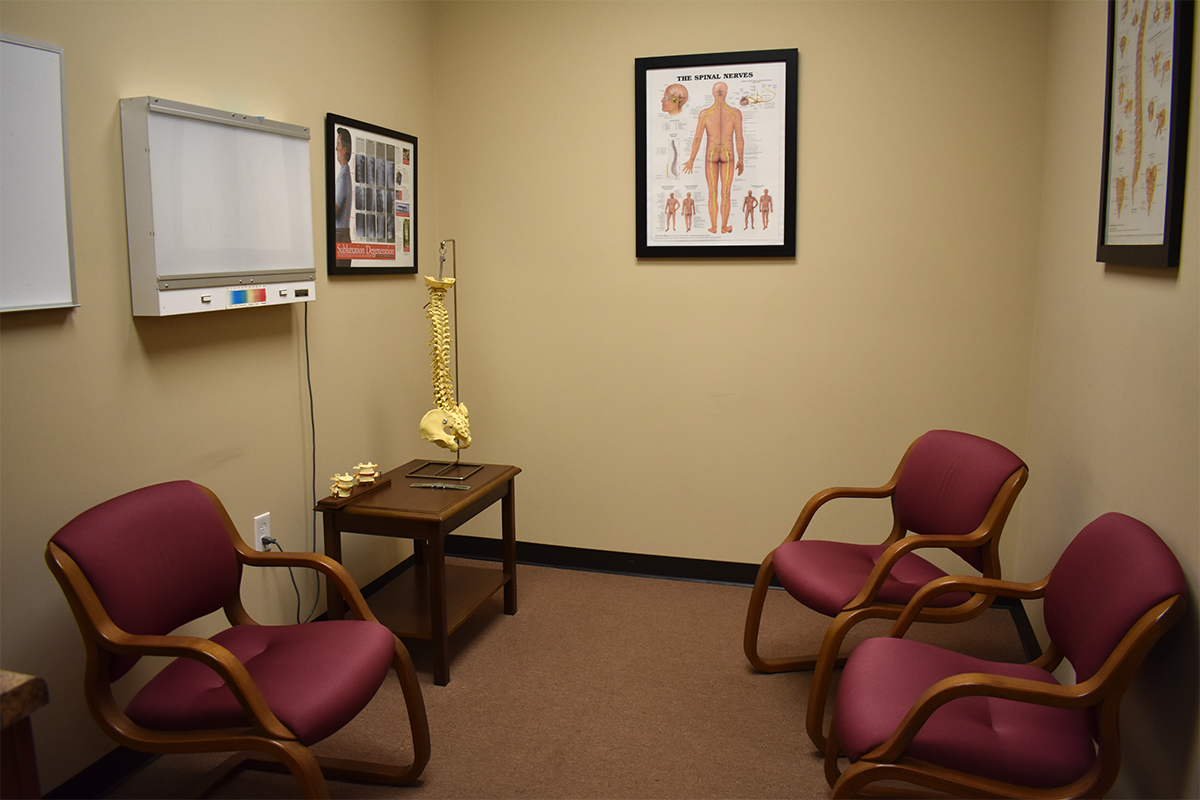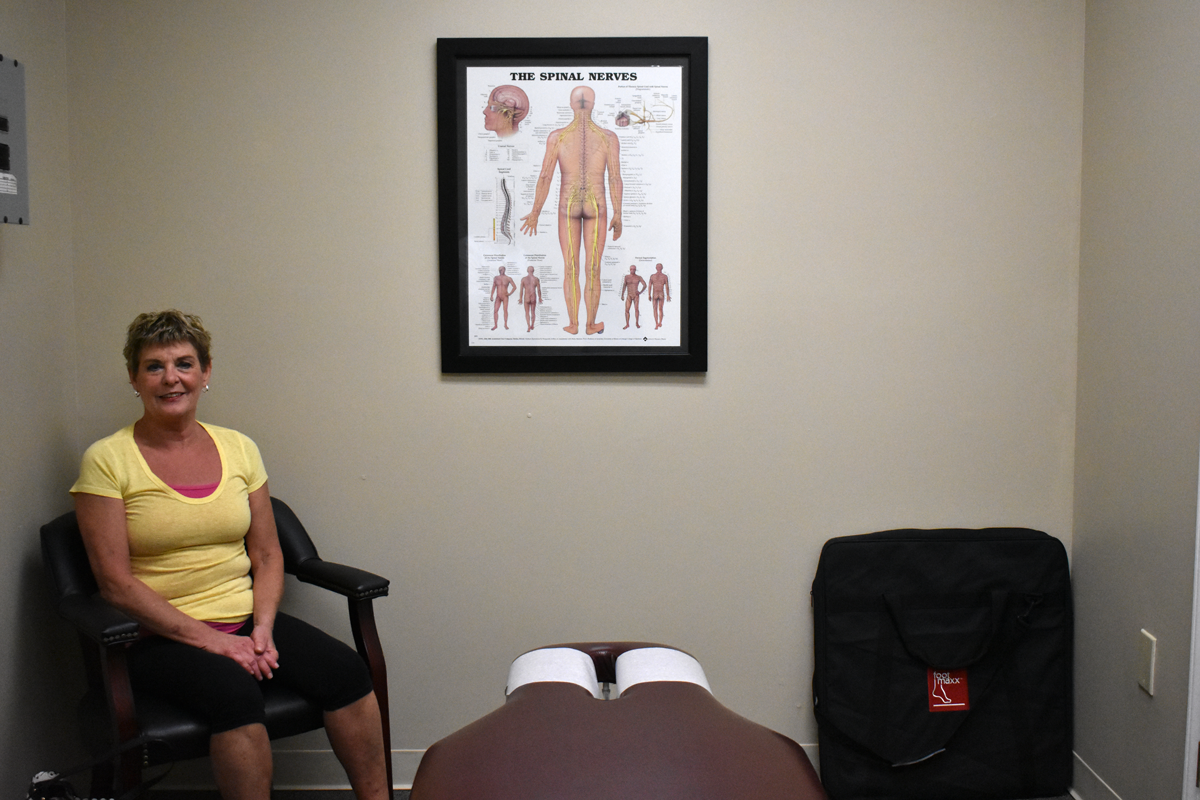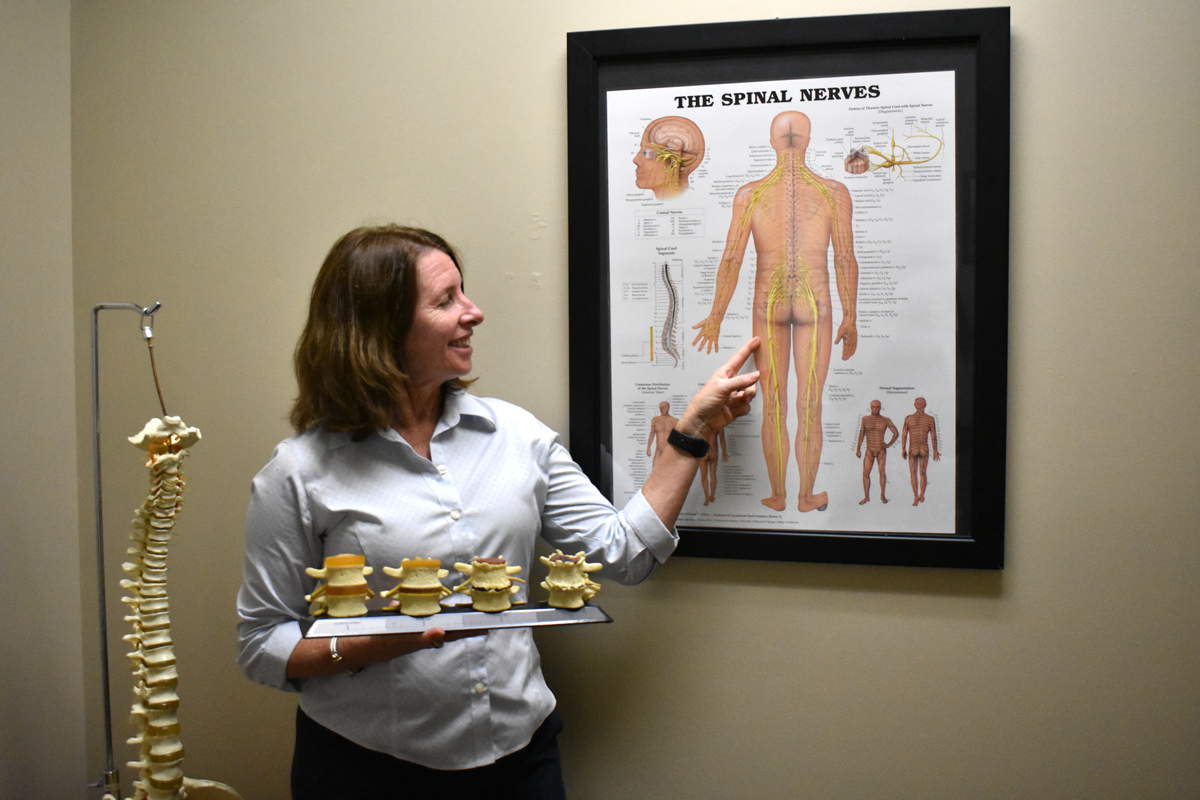Star Country Spot: Amy's Icy Slip and Fall
If you’re a country music lover, you may have recently heard some people talking to 94.9 Star Country’s Brett Sharpe about chiropractic and Tuck Chiropractic Clinic, in particular. We’re working with Star Country Radio to bring real life stories of our patients to listeners in our area.
Hear Amy’s story about how Dr. “Too Tall” Skinner helped her work through an injury from an icy slip and fall accident:
Amy isn’t a stranger to Dr. Skinner’s office. About a year ago, she visited Dr. Skinner after suffering injuries from a car accident. Fast forward to December, Amy slipped and fell on a patch of ice on the stairs outside of her home. All of her injuries from her car accident flared up and then some.
Amy was able to get into see Dr. Skinner so quickly that she was still a little bruised up on her first visit. Though he couldn’t adjust her, he was able to help her stretch through her tight muscles in the meantime. Amy’s almost finished her episodic care and might consider maintenance care in the future to help her prevent the severity of future possible injuries.
Unsure if chiropractic is the solution for you? Amy has some advice: “1. No – you won’t have to keep going forever. Your body will tell you when you need it. 2. It’s the best thing you can do for your body,” she says. “The staff is always friendly and professional and Dr. Skinner always has my best interest during every session.”
About the Writer
tech
How Webster's Technique Can Help Your Delivery

Bringing a child into the world is a beautiful thing, but it does cause a lot of changes to occur in the body. These changes can sometimes bring pain and discomfort. Chiropractic care is a proven, safe way to manage lower back pain and sciatica that often comes with the pressure of carrying a baby for 9 months. Receiving care throughout your pregnancy could help you manage these changes to your body and the strain the extra weight puts on your muscles and spine. But that’s not the only way chiropractic care can make a big difference during your pregnancy.
Webster Technique for a Safer Birth
When a baby is in a breeched position with their bottom in the position to be birthed first, the mother and child could face a high-risk delivery and often times a mandatory cesarean section. This is common in 3-5% of pregnancies. The Webster Technique is a specific chiropractic adjustment that is made to help a late-term pregnant woman whose baby is in the breached position. The doctor can safely manipulate the position of the baby to the proper delivery position.
Essentially, the Webster Technique adjusts the sacrum and relieves tension that is preventing the baby from moving into the proper position. Studies have shown that when the Webster Technique was employed early enough before delivery, 92% of patients were successfully manipulated into the correct position. This allows mothers to pursue a natural, low-risk birth.
Tuck Chiropractic Doctors Are Waiting to Help
Expectant mothers can embrace a safe, natural alternative to find relief during and after their pregnancy. All of our doctors are passionate about helping parents bring new life into the world safely and without unnecessary pain. Schedule an appointment at a clinic near you to find out how we can help.
About the Writer
tech
Chiropractic For Fibromyalgia

The practice of chiropractic care focuses on the spine and nervous system, which control and coordinate your musculoskeletal system and how your body moves and functions. When these systems are out of alignment, they can cause pain, tension, and limited mobility. While we are able to treat anyone with pain, there are certain groups of individuals that suffer from chronic illnesses that can especially benefit from our therapies and adjustments. Chronic illnesses that wreak havoc on the musculoskeletal and nervous system, such as fibromyalgia, can be managed with chiropractic care.
Defining Fibromyalgia
The National Fibromyalgia and Chronic Pain Association defines fibromyalgia as “a chronic pain disorder that causes widespread pain and tenderness to touch that may occur body-wide or migrate over the body.” Other symptoms from fibromyalgia include fatigue, sleep disturbances, cognitive difficulties, and stiffness. It can also express itself in mental conditions and other systemic issues like irritable bowel syndrome.
This illness has existed for centuries but researchers still find it difficult to categorize fibromyalgia and attribute a cause to the disease. Because it is difficult to pinpoint the cause and it expresses itself differently for every person, it’s also difficult to pinpoint the proper medication or treatment for individuals. Often times, people suffering from fibromyalgia have lifelong journey of seeking out a solution for their pain.
How Chiropractic Care Can Help
Because of the complexity of the disorder, fibromyalgia often requires a myriad of treatments to help sufferers find relief. Popular approaches include the combination of patient education on daily habits to help overcome issues, aerobic exercise, cognitive behavioral therapy, medication, and of course, chiropractic. All of these methods can work together in a multidisciplinary approach to tackle the various symptoms and sources of pain to improve the patient’s overall quality of life. While there will never be complete relief from this disorder, we can still make a difference.
Because chiropractors work so closely with the systems that cause pain in fibromyalgia patients, we can use our treatments to reduce pain and strengthen muscles. Using diagnostic techniques, a chiropractor can zone in on where localized pain is coming from even when individuals are experiencing full body pain and tenderness. In 1997, a research study tracked the effectiveness of chiropractic management of fibromyalgia patients. The study consisted of a 4 week regimen of spinal manipulation, soft tissue therapy, and passive stretching. By using the Oswestry Pain Disability Index, Neck Disability Index, and range of motion observations, the study deduced that patients experienced improvement in the cervical and lumbar ranges of motion and reported pain levels. Since this pilot study, research has only strengthened the evidence that chiropractic care can help fibromyalgia patients manage their pain.
We Will Work With Your Primary and Specialty Care Providers
We believe in the power of multidisciplinary collaboration, especially for individuals suffering from complex disorders such as fibromyalgia. Evidence has shown that when medical professionals across areas of expertise are able to communicate and collaborate care around a patient’s complex needs, the outcomes are even more effective. If you’ve sought care from a rheumatologist, orthopedist, physical therapist, or don’t even know where to start. We can help. We will gladly work with your care providers to find the best solution for your needs. Let’s get started today.
About the Writer
tech
Dry Needling: A Little Known Technique That Gets Big Results

If you’re into natural healing and wellness, it’s likely that you’ve already heard of acupuncture and how it can be used with chiropractic adjustments to further release tension in the muscles. Dr. Foster, from our Bedford Clinic, practices acupuncture’s not-so-distant cousin: dry needling. In this technique, doctor uses sterile, fine needles to go deep into muscle tissue to stimulate the nerves in the muscle to release tension. Where manual adjustments typically focus on the skeletal system, these techniques can focus on the muscles – providing a true musculoskeletal treatment.
“In short, what we do as chiropractors focus on the nerves and the pain associated with them,” says Dr. Foster. “Dry needling helps the muscular element of pain by breaking up tight muscle fibers along with scar tissue and allowing them to heal correctly.”
How Does Dry Needling Differ from Acupuncture?
The biggest difference between acupuncture and the dry needling technique is where the doctor targets the needles. Acupuncture is an Ancient Chinese technique that targets “meridians” throughout the body. These meridians are thought to be channels of energy, or “Chi”, that influence the flow of energy in the body. The concept suggests that the needles unblock any energy that is backed up from tension.
In dry needling, the doctor focuses on myofascial trigger points and tender points in the soft tissue throughout the body instead of the meridians. While there may be some crossover, the trigger points are more related to the points where the nervous system and musculoskeletal system are showing abnormal levels of pain and tension – focusing on the root of the problem rather than the energies of the body. One or a number of needles are used depending on the area in treatment and the technique can be administered over multiple sessions. While we are using needles to go deep into the muscle tissue, a lot of patients barely feel it as there is little to no pain and rarely any bleeding with this procedure.
Another way these two techniques differs is the training involved. Often times, acupuncture requires a masters degree so most administers of this technique are restricted to only being able to provide acupuncture services and do not have the ability to diagnose as primary care providers. Dry needling when performed by a chiropractor, after 7-8 years of schooling, requires further specialized training and as a doctor, we have the ability to both diagnose and treat the patient, striving for the best results possible for each patient’s condition.
How Dry Needling Can Help You Heal Faster
In Dr. Foster’s experience, the addition to dry needling to his practice has really taken his treatments to the next level. After receiving dry needling in the past and seeing firsthand the marvelous benefits, he knew he wanted to be able to supplement his other adjustment techniques to provide an added benefit and level of relief to his patients.
“Usually within 2 to 6 visits of including dry needling with their regular treatments, people are seeing a substantial difference with most patients wishing they had tried it sooner,” says Dr. Foster.
Because Tuck Clinic is adamant about tracking outcomes and progress with patients frequently, he has been able to watch treatment plans provide faster resolution and relief with longer lasting benefits. When Dr. Foster is able to combine dry needling with his regular treatments, patients are treated wholly through their skeletal and muscular systems. The added benefits of dry needling help the muscles react to the skeletal adjustments faster, helping patients find continued relief quickly and more efficiently. The dry needling technique is also affordable. Dr. Foster is so devoted and passionate to help the people of his hometown that he has extended this service as the most affordable around. With a flat rate of $35, you won’t have to worry about an acupuncturist’s session or hourly fees.
To learn more about this technique, set an appointment with the chiropractors at Tuck Clinic in Bedford today!
About the Writer
tech
Translating Your Chiropractor: Understanding Your Care Plan
At Tuck Chiropractic, we do our best to provide a warm welcome the minute you walk through the door – whether you’re a returning patient or a new inquiry. It’s important to us to make our patients as comfortable as possible from the first greeting to the final visit of their care plan. Part of that process is making sure we are clearly communicating with you. While medical terms and the idea of a care plan may feel overwhelming, our staff and doctors do a great job of walking you through each step to make sure you’re fully informed. We’re here to share with a few common terms and concepts to help you feel confident and capable of truly collaborating with our doctors to find the best treatments for you!

Common Chiropractic Terms
While we do our best to use clear language that both the doctor and the patient can share, there are still a few medical terms that come up during patient visits that may seem foreign. We’ll put them simply for you.
Misalignment or Subluxation
A Misalignment or subluxation – usually of the vertebrae. It can be a common cause of back pain and neck pain and may be a cause of other pain syndromes that patients present within our clinics. Our Tuck Chiropractic doctors will be able to pinpoint the area of misalignment with an X-ray and talk you through how spinal manipulation techniques can realign your spine.
Spinal Manipulation
Speaking of – what do we really mean by “spinal manipulation“? You may also hear the terms chiropractic adjustment or manual manipulation interchanged with this term. Simply put, this is when the doctor applies his or her hands or uses an instrument to apply pressure to the body in order to realign your vertebrae. It often includes a high-velocity thrust applied to the vertebrae. It sounds intense and you may experience a “popping” sound – but you’ll immediately feel a sense of release in the affected joints.
Electrical Muscle Stimulation
Electrical Muscle Stimulation Therapy is frequently coupled with spinal manipulation treatments as a way to stimulate the muscles surrounding the area in pain. In this way, chiropractors can truly treat the entire musculoskeletal system to help relieve pain and tension. It’s often used before a manipulation to “warm up” the muscles by sending a low-level electrical current through a number of electrodes placed in the affected areas.
Common Phases of Care
It’s important to realize that chiropractic care isn’t a quick fix. It is a process of adjusting the body to its natural state of alignment to relieve pressure and pain. Our doctors work hard to help patients understand every step of the process from intake to outcome review, and beyond. Here’s what to expect from your collaborative care process.
Intake Process
The intake process is painless. Our friendly staff helps you fill out your paperwork and often times, you will receive an X-ray to help the doctor identify the point of misalignment. With this, the doctor will be able to walk you through the treatments you will receive to begin the process of healing and perform the first adjustment. We will never force you into a treatment that you are uncomfortable with. Our priority is your comfort and confidence.
Customized Treatment Plan
Based on your Examination, the intensity of the problem, and your personal goals for feeling better, your doctor will talk you through your adjustment regimen. Often times, there will be a higher frequency of adjustments during the first portion of your care to build upon each adjustment for more effective results. It will begin to taper off once the extended relief sets in.
Reviewing Outcomes
We check in with our patients often to make sure they are getting the results and relief they are seeking – typically every two weeks. This allows our doctors to make sure they’re helping patients meet their goals and to make any adjustments to their care plan that they see fit. Ultimately, this is the most important part of the process: making sure our patients are feeling better and living better.
Maintenance Care
At the end of a treatment cycle, maintenance care is discussed with the patient to see if they would like to continue their adjustments on a more varied basis. Maintenance care is a great way to maintain alignment and even act as a preventative measure for injuries and illnesses.
Do you have more questions about chiropractic care? Review our Frequently Asked Questions or reach out to one of our locations. Our staff and doctors are here to help!
About the Writer
tech
When The Right Person Reads the X-Ray

Some people live half of a lifetime before finding someone that can help them manage their back pain. When Patty ended up in the Emergency Room as the result of excruciating back pain, she knew it was time to seek out other options to find relief. Two days later, this led her to her first appointment with Dr. Kilmer. Seven years later, Patty still sees Dr. Kilmer as regularly as possible.
An X-Ray Can Reveal The Answer
Patty’s first appointment was incredibly eye-opening. After struggling to find out why she had so much back pain for so long, Dr. Kilmer looked over her X-rays and discovered the problem. It turned out that Patty had an extra vertebra in her lumbar spine – which can sometimes lead to instability and extra stress in the spine.
“After that, I didn’t have any reservations about coming because she was the first person to tell me that,” she says. “She followed me for several months after that. It was an amazing recovery to go from excruciating pain to very little pain.”
She began to see results after just a few visits and was able to learn more about her spinal condition and ways to manage it. As life brought new challenges, she and Dr. Kilmer tackled them together.
Maintaining an Active Life
Patty is a tap dancer and tries to stay as active as possible with her grandchildren. Sometimes, this can lead to an unforeseen tumble every now and then, which often results in injury. With the right treatments, she’s able to recover without the use of pain medication every time. When we asked how her continued use of chiropractic care has affected her life, she simply said “a lot!”
“I’m able to keep dancing and doing my exercises. It helps me maintain my wellness and allows me to keep working,” says Patty.
She feels strongly that anyone who is suffering from pain that they can’t seem to find help for to consider chiropractic care as an option, but with one condition: “It’s gotta be Dr. Susan!”
“She’s very thorough and spends the time with you that you need,” she adds. “I really feel like I am in good hands.”
About the Writer
tech
Research Round Up: The Effects of Integrating Chiropractic Care with General Care

At Tuck Chiropractic Clinic, collaboration means a lot of different things. It means communicating clearly with our patients to set attainable wellness and pain management goals; it means calling up a fellow chiropractor to hear their ideas on a new technique or challenge; it also means working with the wider healthcare community to provide a continuum of patient-centered care to provide the measure of support to each and every person we serve. Evidence shows that each of these methods of collaboration leads to higher satisfaction and better outcomes for the patients and the doctors involved.
As the healthcare specialists and generalists become more and more open to collaborating with chiropractors, more and more studies have shown the positive results. We’ve rounded up some incredible evidence of the effect that this type of collaboration has on the overall wellness of the public.
Chiropractic Integration into Private Sector Medical Facilities:
A Multi-site Qualitative Case Study
Anthony J. Lisi, DC, Stacie A. Salsbury, Ph.D., RN, Elissa J. Twist, DC, MS, and Christine M. Goertz, DC, Ph.D.,
Pain Research, Informatics, Multi-Comorbidities, and Education Center, VA Connecticut Healthcare System, West Haven, CT.
Summary: This qualitative study aimed to study the effects and process of incorporating chiropractic care into a conventional medical setting with the goal of integrated care that provides positive outcomes for patients in pain and reduce opioid use and abuse. The study took place in 9 different private sector medical facilities in the United States that have incorporated on-site chiropractic care. There were five hospitals and four clinics involved. Through the gathering of a variety of qualitative data types, the researchers found that the multidisciplinary teams engaged in inter-professional case management for patients with musculoskeletal issues. The research concluded that both patients and doctors showed high levels of satisfaction with the care provided.
Take-Aways: Because patient-centered care that focuses on the integration of medical disciplines achieves more effective outcomes, all parties involved are highly satisfied.
Read Full Text
Management of Back Pain-related Disorders in a Community With Limited Access to Health Care Services: A Description of Integration of Chiropractors as Service Providers
Peter C. Emary, DC, MSc, Amy L. Brown, DC, Douglas F. Cameron, DC,
Alexander F. Pessoa, DC, ICSSP, Jennifer E. Bolton, Ph.D., MA Ed
Summary: This study was designed to evaluate the impact of chiropractic service for patients with back pain in an integrated, multidisciplinary, primary care setting in Cambridge, Ontario, Canada. Patients were referred to the chiropractor by their medical doctor or nurse practitioner and were surveyed at their first and last appointments. Of the 93 patients surveyed, the mean age was 49 and 66% of them were unemployed. 77% of them reported constant back pain that lasted more than a month. Through three different questionnaires, researchers found that the vast majority reported significant improvements in pain and reduction in the use of pain medication. 77% also had no need to visit their primary care doctor during the course of their chiropractic care and 93% of them were satisfied with the service.
Take-Aways: When primary care doctors recognize the opportunity to treat back pain without pain medications, using chiropractic care, the outcomes show high patient satisfaction and relief.
Read Full Text
Interdisciplinary Practice Models for Older Adults with Back Pain: A Qualitative Evaluation
Stacie A. Salsbury, Ph.D., RN, Christine M. Goertz, DC, Ph.D., Robert D. Vining, DC,
Maria A. Hondras, DC, MPH, Ph.D., Andrew A. Andresen, MD, Cynthia R. Long, Ph.D.,
Kevin J. Lyons, Ph.D., Lisa Z. Killinger, DC and Robert B. Wallace, MD, MS
Summary: This qualitative evaluation focused on the treatment of low back pain in older adults 65 years or older. Often times, patients seek care from multiple providers or disciplines, however, the care is not often coordinated collaboratively, but siloed. The study aimed to evaluate the feasibility of a more patient-centered model of care that brings multidisciplinary doctors together. The trials compared the results of three different models for back pain treatment: usual medical care, concurrent medical care with chiropractic care; and collaborative medical and chiropractic care. Through various methods of gathering qualitative data, researchers found that while providers were willing to collaborate, logistics of sharing information and collaborating were difficult. When there was an open flow of communication between all parties, older patients reported satisfaction and positive results.
Take-Aways:
While best practices of interdisciplinary care are still being established, the integrated care model results in higher satisfaction for all parties.
Read Full Text
In Conclusion
The proof is in the patient outcomes. As integrated, patient-centered care models develop, it’s important for primary care doctors, physical therapists, chiropractors, and other disciplinary doctors to work together for the best outcome for the patients. When done right, doctors can work together to reduce the prescription of opioids for patients in pain.
About the Writer
tech
A Behind the Scenes Look At An Adjustment with Dr. Kilmer

On a sunny Wednesday afternoon, Dr. Susan Kilmer welcomed Ella back to the clinic for a low back adjustment with a friendly, familiar smile. That’s because Ella has been seeking chiropractic care from Dr. Susan for the past 19 years! In 1999, Ella sought out some relief from her general lower back pain and found Susan at her independent practice. She has been seeing her ever since and as a loyal patient, she continued to see her once Susan began working with Tuck Chiropractic as needed.
“I’m getting ready to go on a trip to Nebraska,” Ella shared with Dr. Kilmer.
A Behind the Scenes Look
With long car rides often comes lower back pain, so Ella had come for an adjustment to help relieve the pain she was currently experiencing and to prevent any discomfort on her long trek. This is a common occurrence for patients who travel. While most people see chiropractic care as a solution for active pain, it can be equally effective in preventing future pain.
Dr. Kilmer began her work in helping Ella to walk out feeling better and looking forward to her trip. Starting with an electronic massage device, Dr. Kilmer “warmed up” Ella’s lower back muscles to help the adjustment perform as much as possible. She also prefers to do some muscle work at trigger points across the back to make sure the muscles and spine are completely prepared for the adjustment. While not all chiropractors do this as a best practice, she finds that often times it can make a big difference in helping the patient relax enough for the adjustment to set in.
Decades And Generations of Finding Relief
There’s something to be said about working with a doctor that is familiar with you, your life, and your wellness needs. It’s clear that Ella and Dr. Kilmer have built up a strong relationship over the past two decades. Throughout Ella’s visit, she and Susan talked like family friends. In fact, Susan could even be considered an honorary member of the family. She has treated Ella’s in-laws, nieces, and nephews for their own pain management, too!
After a few adjustments in her lower back and neck, Ella was on her way and already discussing the possibility of another appointment before she leaves for her trip “just in case!”.
“Chiropractic has been very important to me and helping me maintain my mobility,” said Ella. She encourages anyone who is considering chiropractic to give it a try, and of course, see Dr. Kilmer.
As she began to say good bye to Dr. Kilmer and Brandy at the front desk, she exclaimed: “It already feels better, Susan!”
About the Writer
tech
Protecting Your Child's Back This School Year

For most families, one of the focal points of back-to-school time is picking out the perfect backpack. While the kids focus on the aesthetics – the colors, amount of zippers, and extras that come with it – it’s your responsibility as a parent to focus on the function. The average McGraw-Hill standard textbook weighs 3-4 lbs. across age groups of students. Combine 4 to 7 of those textbooks with other supplies like notebooks, pencils, and a calculator and your child’s backpack is suddenly a heavy load to bear. If you have a student-athlete, you can expect additional weight added by a duffel bag of sports equipment and practice clothes.
A cross-sectional study of Italian students in 2016 showed that out of 5,318 students, 60% of those students experienced back pain related to the load and extended time of use of their backpack. In particular, adolescent girls seemed to struggle the most with chronic back pain due to the need to tote a heavy load throughout the day. Due to the excessive strain placed on the shoulders and lower back to carry these loads, some students can even experience spinal compression throughout their schooling if not properly supported and treated. While parent’s don’t have control over what textbooks teachers assign their students, there are a few things they can do to help their children avoid the pains of carrying a heavy backpack load.
Finding the Right Backpack
Finding a backpack that fits both form and function for your child is no easy task, but it isn’t impossible. If you’re trying to find the right fit for your back-to-schooler, there are a few key elements to look for:
– Wide, padded straps provide extra support and relieves strain on the shoulders.
– Multiple compartments to prevent weight from being centralized to one area.
– Adjustable straps so that the weight does not sit more than 4 inches below the waist.
– An additional support strap across the waist or chest can also help lighten the load.
*Bonus Tip* Make sure your child wears their backpack with both straps to balance the weight! Try to avoid messenger bags that can put a strain on a single shoulder.
Working with the School
The recommended weight for a student’s backpack is between 10 and 20 percent of their total body weight. Unfortunately, it is hard for schools to oversee the issuance of books and supplies based on this guideline, because growing kids in a single age group tend to fall in a wide range of shapes and sizes! That doesn’t mean your child has to suffer the consequences of being smaller with a heavier load.
Talk to your administrators and teachers about the possibility of acquiring two sets of books for your students – one that can stay at home and one that can stay in the classroom or locker. This will alleviate the need for the child to tote around the heavy books all day as well as to and from school. You might also be able to access some textbooks with an online version, further eliminating the need for your child to carry their books all the way home.
Chiropractic Care for Children & Teens
If you find that your student is still struggling with back pain as a result of a heavy backpack, lack of back support in desks, or any other challenge that going back to school presents, we’re here to help. We can provide a gentle spinal manipulation that can realign your child’s back and help them find relief. It’s also a great measure to improve the immune system – an extra line of defense against all those fresh germs!
About the Writer
tech
How to Communicate Your Pain
Have you ever had to explain the sound your car is making to a mechanic? If you’re not mechanically inclined you may have a tough time capturing the exact sound, therefore leaving the mechanic confused as to the source of the problem. We often run into this problem when we are in pain, too. We know it hurts, but we can’t quite identify where or what the pain is. Communication is key when working with a chiropractor and your path to recovery.

Chiropractors Know What To Look For
The pressure is not all on you. Chiropractors are trained to look for nonverbal as well as verbal cues when dealing with patients in pain.
Tuck Chiropractor, Dr. A.J. LaBarbera, explains how he picks up on his patients’ pain:
“Many patients will give an accurate account of their pain. However, many patients will nonverbally communicate their pain by limping, favoring an arm or leg, frowns or grimaces when an area is touched, and general irritability.”
All of these can be cues to pain and the ways that patients will give non-verbal communication of their pain.
“Often times, we have to look beyond the obvious to identify where the true source of pain is coming from based on non-verbal cues”, says Dr. LaBarbera.
Your Lifestyle Speaks For You
While communicating your pain can be difficult, chiropractors will benefit by knowing as much as possible about your current and previous lifestyle habits. This can help them identify the source of pain or identify potential traumas.
For example, knowing that a patient with shoulder pain used to be an avid softball player and was the pitcher for their team can point out that their shoulder has probably been overworked and has possibly encountered some trauma. Or maybe you just recently acquired a new hobby of leisurely biking. If you are suddenly experiencing knee pain, your new activity may have flared up your recent discomfort. It’s important to provide as much context as possible about your previous lifestyles and recent lifestyle changes.
The most important thing to remember is to be transparent with your chiropractor. Their goal is to help you recover and live pain-free. Be open, honest, and willing to learn when you talk to them and you should have an effective path to recovery.
If you have any questions about what to expect from your first visit with a chiropractor, learn more here.
About the Writer
tech
You may also be interested in...

What Does a Healthy Spine Feel and Look Like?
Your spine is the backbone of your overall health—literally. It supports your body, protects your nervous system, and helps you move with… Read More

How Do Chiropractic Adjustments Work?
Chiropractic care focuses on the health and alignment of the spine, recognizing its vital role in overall well-being. A central component of… Read More

6 Types of Chiropractic Adjustments and How They Work
Chiropractic care is a popular form of healthcare focused on spinal health and overall well-being. Chiropractors use a variety of techniques to… Read More

7 Researched Benefits of Chiropractic Adjustments
Chiropractic care focuses on maintaining spinal health and addressing misalignments that can cause a variety of health issues. The practice is growing… Read More
